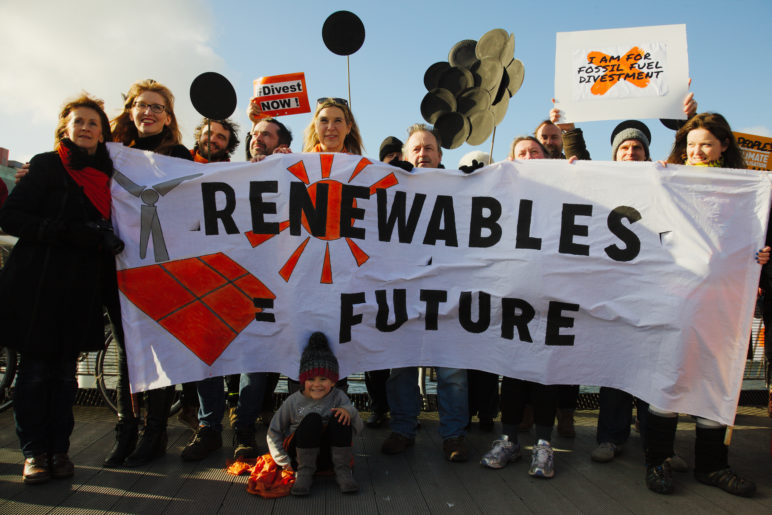While the Trump Administration is rolling back regulations that reduce climate pollution, a transformational counter-process is rolling forward in the Northwest. A biennial planning process by electric utilities is taking big strides toward the region’s clean energy goals. And, the utility planning process itself is undergoing a makeover that will enable even faster progress in the future.
To meet the new requirements laid out in Oregon and Washington laws, each utility is writing a new Integrated Resource Plan to serve as the playbook for meeting the region’s power needs.

Recently-passed legislation in the Northwest mandates a complete phaseout of coal for electricity production while amping up requirements for renewable power. To comply with the new laws, Northwest electric utilities are planning for unprecedented amounts of renewable power and conservation. Plus, a serious conversation about carbon is taking a turn in the spotlight.
Washington’s Clean Energy Transformation Act—passed last year and so far the most aggressive legislation in the nation advancing carbon-free electricity—requires a full phaseout of coal power by 2026, a transition to totally carbon-neutral electricity by 2030, and 100 percent carbon-free electricity by 2045. Oregon’s Clean Energy and Coal Transition Act of 2016 transitions the state’s utilities off coal generation by 2030 and mandates that at least 50% of each utility’s power must come from clean energy sources by 2040. (Idaho is not making strides toward carbon-free electricity through legislation, but the state’s largest utility announced that it would phase out coal and provide its customers with 100% clean energy by 2045.)
To meet the new requirements laid out in the Oregon and Washington laws, each utility is writing a new Integrated Resource Plan (IRP) to serve as the playbook for meeting the region’s power needs. Produced every two years, IRP’s set out 20-plus year plans that include a detailed analysis of each utility’s long-term power resource needs, as well as the estimated costs and risks of these needs.
Cascadia has always had a sizeable base of renewable power, in the form of hydroelectricity, but hydro is only a part of the region’s energy. For years, Northwest utilities have augmented their portfolios with thermal fossil fuel power, specifically coal and natural gas, as well as nuclear-based electricity. That was especially true for investor-owned utilities like PSE and PacifiCorp until things began to change in 2006 and 2007, when renewable portfolio standards were first passed by the legislatures of Oregon and Washington and the utilities in those states started adding additional renewable resources to their power generation portfolios.
Not all the changes are coming easy, though. New membership in the IRP stakeholder groups has introduced more controversy than has been typical. For years, only a small group of experts advised and strongly influenced the direction of IRPs. That’s changing as environmental advocacy groups are learning to harness the IRP process to pressure utilities to improve outcomes like reducing carbon emissions and limit natural gas use. They are perhaps emboldened by the impact that activist stakeholders had on Portland General Electric’s IRP a few years ago. When the utility proposed building two new natural gas-burning plants in its 2016 IRP, the proposal was met with fierce opposition. Stakeholders packed public meetings to voice their disapproval and the Oregon Public Utilities Commission ultimately admonished the utility for weak analysis. In its latest IRP, Portland General Electric abandoned plans for new natural gas generators, doubling down on renewable resources instead.
So, what’s happened so far in this round of IRP development?
For starters, investments in wind power and conservation by customers are coming out on top from a cost perspective. By calculating the “levelized cost of electricity”, utilities can make an apples-to-apples comparison of the cost of producing power from different resources over the life of various types of power plant installations. And by this metric, wind is enjoying the coveted position of the “least cost resource,” while decreases in solar costs have put it on-par cost-wise with natural gas for power generation. Meanwhile, saving energy through conservation and appliance efficiency, a stalwart feature of IRPs, will be getting more attention (and funding), which means that Northwest energy users—you and me—will play a meaningful role in meeting the terms of the new clean energy laws.
Furthermore, carbon emissions and climate will play a more important role than ever. Requirements to model the risk to utilities’ balance sheets of a future price on carbon emissions has been in place for a while, but new mandates in Washington are driving the utilities to use a common statewide approach that assigns a cost to the damages from greenhouse gas emissions with results provided by the Interagency Working Group on Social Cost of Greenhouse Gases. Going forward, the costs of all power resources will have to reflect their climate impacts. In other words, damages from greenhouse gas emissions—impacts to human health, property value reductions, and declines in agricultural productivity, for example—will be counted as costs, which will make portfolios with high carbon emissions start to look a lot more expensive.
Modeling all of these factors isn’t easy though. In fact, the analysis is so complicated (and so new) that it poses some challenges to the software tools themselves. Tuned to the regulations of yesteryear, these sophisticated models need rapid and extensive updating, which in turn requires input from myriad sources that must themselves be coordinated—software modeling tool providers, utility staff, consultants, regulators, regional power planners, and market participants.
The models have improved since the passage of the new laws, but there is still more to do. In their early attempts to model portfolios that would comply with Washington’s new laws, utilities were still forecasting fossil fuel generation past 2045, contrary to the law’s requirements, in large part because the models were not designed to handle such radical change from previous plans. The technical challenges are serious enough that Washington actually granted utilities an exemption from their 2019 IRP filing deadline, pushing the next official IRP to 2021 in order to allow time to work through the thicket of rulemaking, modeling, and stakeholder engagement necessary to successfully implement the new clean energy laws.
Buried in all the complexity is a risk of unintended consequences with the new laws that deserves attention: multi-state utilities like Avista and PacifiCorp may be able to take advantage of weaker regulation in other states to limit their overall investment in clean energy. If they generate enough renewable energy anywhere to meet the clean energy standards in one state, they may decline to make further investments in renewables and instead simply rearrange their books. By indicating that the fossil-fuel portion of their electricity generation is attributable to states with more lax regulations, these utilities may be able to avoid actually cleaning up their power portfolios.
As Washington and Oregon utilities divest from coal, the best outcome from a climate perspective is that their coal plants are retired, never to be used again to generate electricity, but this may not be the ultimate outcome. In December, PSE announced a deal to sell part of its interest in Colstrip to NorthWestern Energy (another co-owner of Colstrip) for $1. The move, if approved, will allow PSE to have it both ways: it can purchase the fossil-fuel power until Washington law prohibits it in 2026, but it would no longer be responsible for operational costs or future remediation costs that are likely to come with an aging coal plant. (NorthWestern customers would be on the hook for those costs.) A similar outcome is possible in Wyoming as PacifiCorp looks to retire its Jim Bridger coal plant and faces uncertain legislative action that may require it to sell the plant rather than retire it.
A slew of officials—utilities, regulators, and multiple divisions of state agencies—are grappling with the new clean energy laws, aiming to have them operational for the new round of IRPs by January 2021. Yet even while they work, Washington legislators are considering a new round of legislation, including bills that would clean up the transportation sector (by electrifying portions of it), restore salmon habitat (potentially limiting hydropower), and more strictly limit the state’s greenhouse gas emissions. In Oregon, lawmakers are debating a carbon cap and trade bill that could have big implications for resource planning by electric utilities, as well as for other sectors like transportation and industry. Any of these bills, if passed, would have consequences for regional utility planning, driving the region even faster toward a clean energy future.
Laura Feinstein volunteers with Sightline researching energy policy. She spent 11 years in the utility industry, working in energy conservation and engineering.












roxa
Neither the Montana Public Service Commission (PSC) nor the Washington Utility and Transportation Commission (UTC) have approved the sale of a portion of PSE ownership in Colstrip generating power to NorthWestern Energy. As of today, 02/10/2020, the PSE has not filed its application material with the UTC. No sale has been completed. A sale has only been proposed. My understanding is that if either the Montana PSC or the UTC says no, then the proposed sale doesn’t happen. Please make this correction to your otherwise informative story. Thank you.
Eric de Place
Thanks, Roxa. We’re amending the article accordingly.
Linda
Well, if you can’t get carbon based fuel out of Puget Sound Energy, you can get out of PSE by creating a public utility. East King County and Thurston County are pursuing an initiative process to do just that. Public utilities answer to the public, not to for-profit private investors.